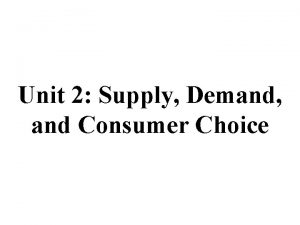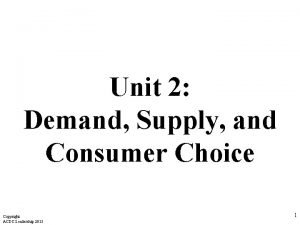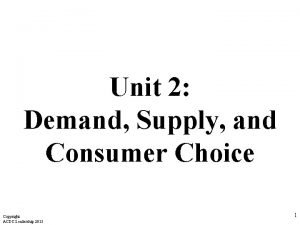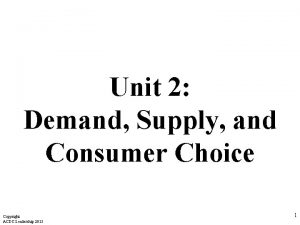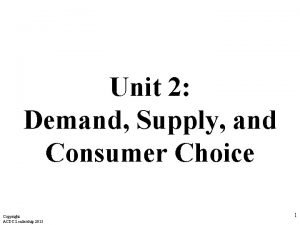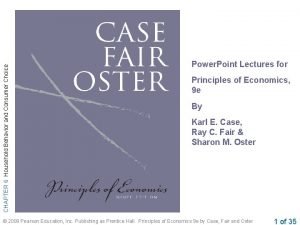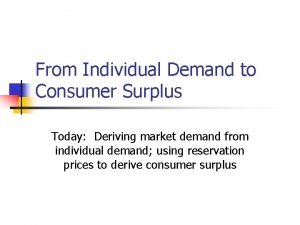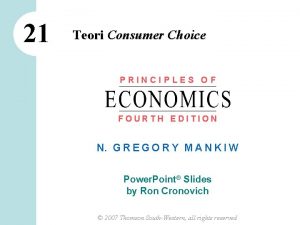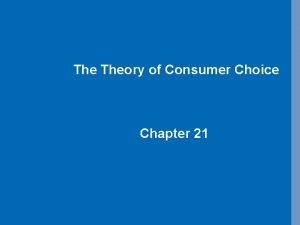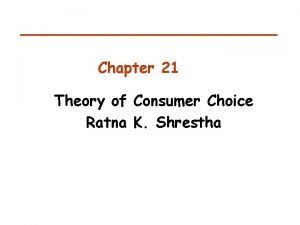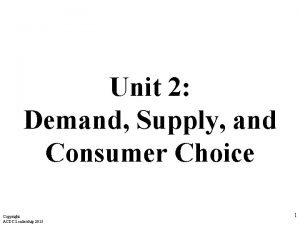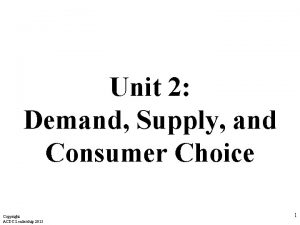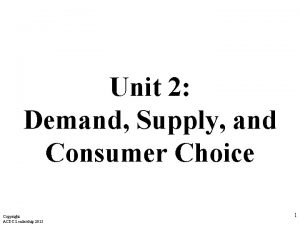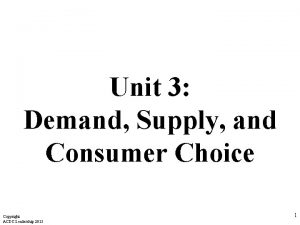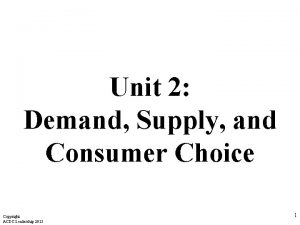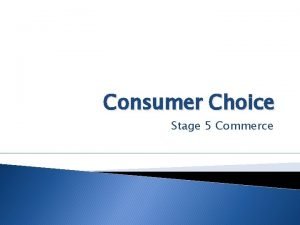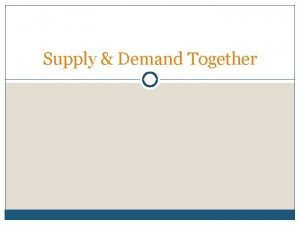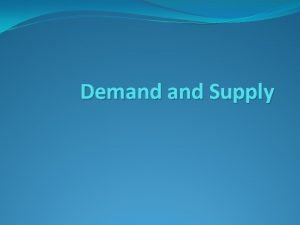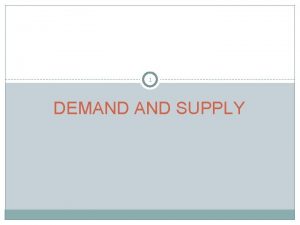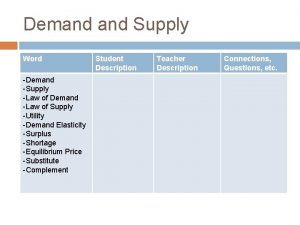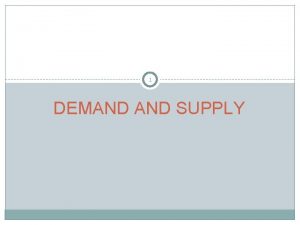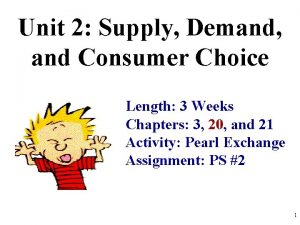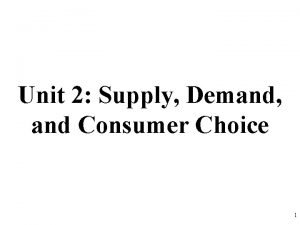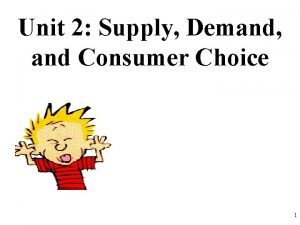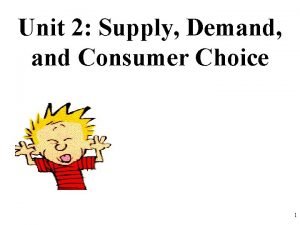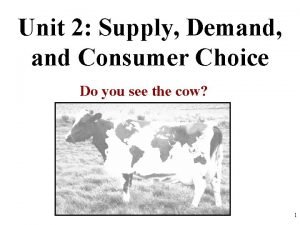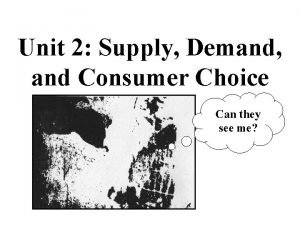Unit 2 Demand Supply and Consumer Choice Copyright





























- Slides: 29

Unit 2: Demand, Supply, and Consumer Choice Copyright ACDC Leadership 2015 1

Trade and Taxes Copyright ACDC Leadership 2015 2

Review P $22 Calculate the area of: 1. Consumer Surplus 2. Producer Surplus 3. Total Surplus S 20 CS 1. CS= $40 2. PS= $20 3. Total= $60 18 PS 16 14 Copyright ACDC Leadership 2015 D 20 Q 3

Limits on Trade World Price- Countries can buy products at their own domestic price or they can buy the products at a cheaper world price Tariff- Tax on imports that increases the world price Quota- a limit on number of imports. Purpose of tariffs and quotas: • To protect domestic producers from a cheaper world price. • To prevent domestic unemployment Copyright ACDC Leadership 2015 4

International Trade and Quotas Identify the following: 1. CS with no trade 2. PS with no trade 3. Amount we import at world price (PW) 4. PS if we trade at world price (PW) 5. CS if we trade at world price (PW) 6. If government tariff This graphs show the domestic leads to a world price supply and demand for grain. of PT, how much is The letters represent area. imported and what is the CS and PS? Copyright ACDC Leadership 2015



Copyright ACDC Leadership 2015

Excise Taxes Excise Tax = A per unit tax on producers For every unit made, the producer must pay $ NOT a Lump Sum (one time only)Tax The goal is for them to make less of the goods that the government deems dangerous or unwanted. Ex: • Cigarettes “sin tax” • Alcohol “sin tax” • Environmentally Unsafe Products • Etc. Copyright ACDC Leadership 2015 9

Excise Taxes Supply Schedule P Qs $5 140 $4 120 $3 100 Government sets a $2 per unit tax on Cigarettes P 4 3 $2 80 2 $1 60 1 Copyright ACDC Leadership 2015 S $5 D 40 60 80 100 120 140 Q 10

Excise Taxes Supply Schedule P Qs $5 $7 140 $4 $6 120 $3 $5 100 Government sets a $2 per unit tax on Cigarettes P 4 3 $2 $4 80 2 $1 $3 60 1 Copyright ACDC Leadership 2015 S $5 D 40 60 80 100 120 140 Q 11

Excise Taxes Supply Schedule P Qs $5 $7 140 $4 $6 120 $3 $5 100 P S $5 4 Tax is the vertical distance between supply curves 3 $2 $4 80 2 $1 $3 60 1 Copyright ACDC Leadership 2015 STAX D 40 60 80 100 120 140 Q 12

Excise Taxes 1. 2. 3. 4. 5. Identify the following: Price before tax Price consumers P pay after tax $5 Price producers get after tax 4 Total tax revenue for the 3 government before tax 2 Total tax revenue for the 1 government after tax Copyright ACDC Leadership 2015 STAX S D 40 60 80 100 120 140 Q 13

Tax Practice 1. 2. 3. 4. 5. Copyright ACDC Leadership 2015 CS Before Tax PS Before Tax CS After Tax PS After Tax Revenue for Government 6. Deadweight Loss assuming society wants Q 2 produced 7. Amount of tax revenue producers pay

2012 Question 18 Copyright ACDC Leadership 2015 15

2012 Question 19 Copyright ACDC Leadership 2015 16


Excise Tax P S $14 12 11 8 D 10 12 Copyright ACDC Leadership 2015 Q

Excise Tax P Stax 1. 2. S 3. Pc$14 4. 12 Pp 11 5. 8 D 10 12 Copyright ACDC Leadership 2015 6. Q Calculate Tax Per Unit Total Tax Revenue Amount of Tax paid by consumers Amount of Tax paid by producers Total Expenditures Total Revenue for firms

Excise Tax Copyright ACDC Leadership 2015 Calculate 1. CS Before Tax 2. Total Expenditures Before Tax 3. Tax Per Unit 4. Total Tax Revenue that goes to Government 5. Amount of Tax paid by consumers 6. Amount of Tax paid by producers 7. Total Expenditures after tax 8. Total Revenue for firms after tax 9. CS After Tax 10. DWL

Tax Incidence Who ends up paying for an excise tax? Copyright ACDC Leadership 2015 21

EXCISE TAX ON MILK P $10 Demand- Inelastic Supply- Unitary S 8 6 $2 TAX on Producers 5 4 2 D 8 10 Copyright ACDC Leadership 2015 Q 22

EXCISE TAX ON MILK P $10 S 1 S 8 $6. 50 =Pconsumers 7 6 5 $4. 50 = Pproducers 4 Amount Consumers Pay $2 TAX on Producers Amount Producers Pay 2 D 9 10 Copyright ACDC Leadership 2015 Quantity Doesn’t Fall VERY Much!!! Q 23

EXCISE TAX ON BEEF P $10 Demand- Elastic Supply- Unitary S 8 $2 TAX on Producers 6 5 4 D 2 8 10 Copyright ACDC Leadership 2015 Q 24

EXCISE TAX ON BEEF P $10 S 1 S 8 $2 TAX on Producers 6 Pc 5 4 Pp DWL? D 2 Copyright ACDC Leadership 2015 7 10 Quantity Falls A lot!!! Q 25

P $10 EXCISE TAX S 1 S 8 Pconsumers = $7 7 6 CS After 1. 2. 3. 4. 5. 6. 5 Pproducers = $4 4 2 Tax per Unit? Total Tax Revenue? Tax paid by consumers? Tax paid by producers? Total spending? Revenue for businesses? D 20 30 Copyright ACDC Leadership 2015 Q 26

P $10 EXCISE TAX S 1 S 8 Pconsumers = $7 7 6 CS After 1. 2. 3. 4. 5. 6. 5 Pproducers = $4 4 Tax per Unit = $3 Total Tax Revenue = $60 Tax Paid by Consumers = $40 Tax Paid by Producers = $20 Total Spending = $140 Revenue for Businesses=$80 2 D 20 30 Copyright ACDC Leadership 2015 Q 27

Tax Incidence (Who pays? ) ST S D D Perfectly Inelastic Tax burden paid mostly on entirely by consumers Copyright ACDC Leadership 2015 D D D Relatively Inelastic ST S Unit Elastic Tax burden shared by consumers and producers Relatively Elastic Perfectly Elastic Tax burden paid mostly on producers entirely by producers 28

2008 Audit Exam
 Unit 2 demand supply and consumer choice
Unit 2 demand supply and consumer choice Unit 2 demand supply and consumer choice worksheet
Unit 2 demand supply and consumer choice worksheet Unit 2 demand supply and consumer choice
Unit 2 demand supply and consumer choice Unit 2 demand supply and consumer choice answer key
Unit 2 demand supply and consumer choice answer key Unit 2 demand supply and consumer choice
Unit 2 demand supply and consumer choice Unit 2 demand supply and consumer choice
Unit 2 demand supply and consumer choice Primary consumer trophic level
Primary consumer trophic level Module 5 supply and demand introduction and demand
Module 5 supply and demand introduction and demand Matching supply and demand in supply chain
Matching supply and demand in supply chain Tipse economics
Tipse economics Unit 3 aggregate demand aggregate supply and fiscal policy
Unit 3 aggregate demand aggregate supply and fiscal policy Unit 3 aggregate demand aggregate supply and fiscal policy
Unit 3 aggregate demand aggregate supply and fiscal policy Unit 3 aggregate demand aggregate supply and fiscal policy
Unit 3 aggregate demand aggregate supply and fiscal policy Two household chapter 6
Two household chapter 6 Characteristic of consumer behaviour
Characteristic of consumer behaviour Chapter 5 consumer markets and buyer behavior
Chapter 5 consumer markets and buyer behavior 1. individual demand and consumer surplus
1. individual demand and consumer surplus Good choice or bad choice
Good choice or bad choice Consumer choice theory adalah
Consumer choice theory adalah The theory of consumer choice chapter 21 practice
The theory of consumer choice chapter 21 practice Chapter 21 the theory of consumer choice
Chapter 21 the theory of consumer choice Decomposer in the sahara desert
Decomposer in the sahara desert Cengage
Cengage Consumer behaviour research process
Consumer behaviour research process Measures to correct excess and deficient demand
Measures to correct excess and deficient demand Dependant demand
Dependant demand Demand curve
Demand curve Demand estimation and demand forecasting
Demand estimation and demand forecasting Distinguish between individual demand and market demand
Distinguish between individual demand and market demand Dependent and independent demand in inventory management
Dependent and independent demand in inventory management
